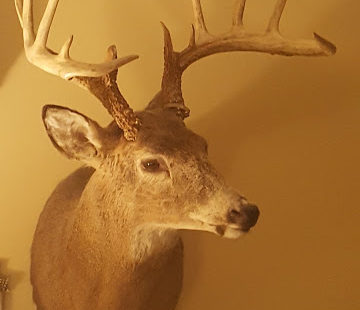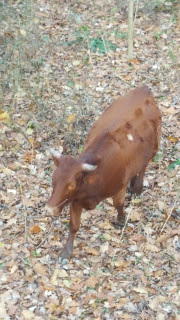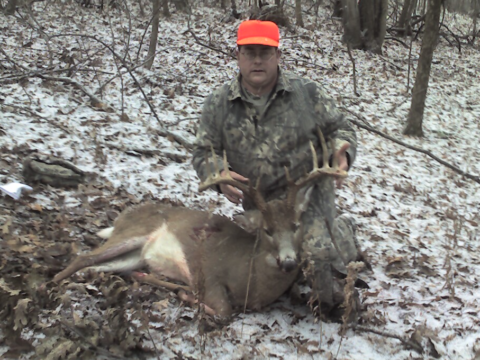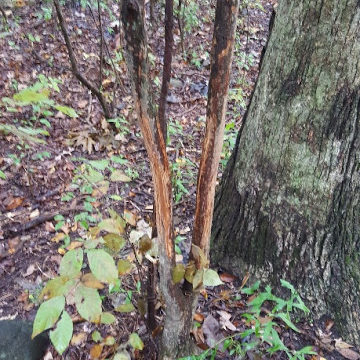
by Eric Hall
The 2008 Ohio firearms season brought with it incredibly high winds, snow and my biggest buck to date. By taking advantage of unique terrain features on this farm, I was able to harvest a 145 inch 13 point with a 23 and 7/8 inch inside spread.
The wind howled on opening morning of the 2008 Ohio gun season. Temperatures hovered near freezing and the wind speeds were upwards of 40 mph. Not ideal, by any means, but it was opening day. I was fortunate to have a ground blind set up on what we called the “Escape Valley”, an area on the farm where deer bolted when under pressure. I felt confident in my setup and settled into the blind at 5 AM, ready for action.
As morning broke, shots began to ring out around me. The neighbors were seeing deer and I felt it was only a matter of time before a pressured whitetail buck would move through the area. The hours passed without a single deer sighting. At noon, I had to leave the blind and head home. My wife was pregnant with our second child and she had a doctor’s appointment that day. Talk about bad planning, opening day of deer gun season and I had to leave the woods.
I exited the blind and began walking out. I used the rolling terrain and tree lines to cover my exit route. Slipping along the bottom side of the ridges, through the sparse timber and around the big knob in the center of the field. The tree line makes a 90-degree bend at one point and the terrain drops off sharply into a bottom pasture area behind the barn. I had always wondered why I had never jumped deer from this location that was choked with thick cover. I slung my weapon over my shoulder as I neared the bend. In the pasture below, the farmer had corralled his horses to keep them out of the pasture during deer season. Knowing this, I always secured my weapon when arriving at this spot, unwilling to take even a small chance on injuring one of their horses.
 I had just begun walking up the slight incline in the field along the thick trees and brush when I heard a deer breaking out of the cover. I was not ready at all for this to happen. One, I was shocked to be jumping a deer from this location, and two, my gun was on my shoulder. The deer emerged in front of me, moving away from the barn and the horses in a safe direction for a shot. It was a large ten point buck and he was 50 yards away and moving fast. I attempted to get my gun off my shoulder and find the deer in my red dot before he crested the knob of the hill. Unfortunately, I was not able to get on the deer and he made his exit towards the adjacent woodlot out of range and out of sight. Dejected, I left the field for the day thinking of what might have been.
I had just begun walking up the slight incline in the field along the thick trees and brush when I heard a deer breaking out of the cover. I was not ready at all for this to happen. One, I was shocked to be jumping a deer from this location, and two, my gun was on my shoulder. The deer emerged in front of me, moving away from the barn and the horses in a safe direction for a shot. It was a large ten point buck and he was 50 yards away and moving fast. I attempted to get my gun off my shoulder and find the deer in my red dot before he crested the knob of the hill. Unfortunately, I was not able to get on the deer and he made his exit towards the adjacent woodlot out of range and out of sight. Dejected, I left the field for the day thinking of what might have been.
That evening I began thinking about why the buck was in that cover. Why would I hunt a location for 15 years and only now see a deer bedded down in this spot? What was different about today? Then it hit me, it was the wind! The wind had been blowing at my back on the way out. The drop off of the terrain and thick cover provided the deer protection from the cold wind. The wind would blow over the top of the drop-off and the deer bedded just over the edge would be able to stay out of the wind.
The next day called for more high wind and cold temperatures, my plan was hatched.
Tuesday, I entered my ground blind at 5 AM and waited for daylight. The weatherman was right for once, with a snow squall and 40 MPH winds hitting the woods in the first hour of daylight. The snow was not heavy but covered the ground in just a few minutes; the wind, however, sustained. While I was in my blind, protected from the wind and snow, I still struggled to keep warm enough. I laughed as the snow started, knowing that my buddy was a mile away, in my ladder stand, trying to stay warm too.
My cell phone buzzed about 10:30 AM. It was work, needing me to come in because someone called off today. I was the manager and needed to either find a replacement or go in and cover the shift myself. Shaking my head, I packed up and exited the blind. Another day of hunting was about to be cut short. Just my luck.
Following the same route, I neared the bend in the trees. I paused to note the terrain and decided to hug the bend tight to the drop off attempting to force any deer bedded in the location to exit in front of me. I still put my shotgun on my shoulder but did not use the sling. This time, I would be ready.
 I started up along the edge, moving slowly, eyes and ears alert for movement. I had just reached the spot where the buck exited the cover the day before and the woods exploded behind me. Turning to look over my right shoulder I saw a wide rack buck breaking down the hill 25 yards away and in the wide open. The problem was he was between me and the farmer’s horses, no shot. I didn’t even pull up. Instead, I watched the deer break behind me, traveling in the direction I had just come. It turned to my left away from the horses and I shouldered my gun. Looking at the path the deer was on, I found the only opening available and settled in. When the buck hit the opening, he stopped in his tracks and looked at his back trail. He was clear of the horses, no hunter orange behind him, it was now or never. I settled the red dot just behind his front right shoulder and squeezed. The report of the Winchester 1300 12 gauge echoed through the valley and the whitetail turned and ran up the hill. Perplexed, I watched the buck run off. The deer never reacted to the shot, and also wounded deer normally run downhill. Kicking myself for missing an opportunity two days in a row, I continued to watch the deer run through the thick cover. I was focused on the black on his tail as he navigated the hill away from danger.
I started up along the edge, moving slowly, eyes and ears alert for movement. I had just reached the spot where the buck exited the cover the day before and the woods exploded behind me. Turning to look over my right shoulder I saw a wide rack buck breaking down the hill 25 yards away and in the wide open. The problem was he was between me and the farmer’s horses, no shot. I didn’t even pull up. Instead, I watched the deer break behind me, traveling in the direction I had just come. It turned to my left away from the horses and I shouldered my gun. Looking at the path the deer was on, I found the only opening available and settled in. When the buck hit the opening, he stopped in his tracks and looked at his back trail. He was clear of the horses, no hunter orange behind him, it was now or never. I settled the red dot just behind his front right shoulder and squeezed. The report of the Winchester 1300 12 gauge echoed through the valley and the whitetail turned and ran up the hill. Perplexed, I watched the buck run off. The deer never reacted to the shot, and also wounded deer normally run downhill. Kicking myself for missing an opportunity two days in a row, I continued to watch the deer run through the thick cover. I was focused on the black on his tail as he navigated the hill away from danger.
Then I saw it. The tail was tucked tight to his body and it looked like he was wobbling. Peering harder at the deer, he was indeed wobbling and it looked like he was going down. Still not 100 percent sure, I thought to myself, “Man I may have just shot a nice buck”. I sat down on the edge of the field and called work. It was clear that they were going to have to cover the shift today.
After giving the deer 30 minutes, I began walking towards where I last saw the deer. Down the valley on the near side and up the other. The hill was so steep that I had to crawl up to make it to the top. Finally, I reached the trail and I saw blood in the snow. My heart began to beat out of my chest as now I knew I had hit him. I followed the blood for 30 yards and it quit. Fearing the worst, I looked into the snow and saw the track heading to my right. Turning to follow the track, I saw antlers 40 yards away. He was down!
 I walked up to the buck and immediately started shaking. I had to unload my shotgun, fearing I might accidentally discharge the weapon because I was shaking so badly. The spread on this deer was incredible, one of the widest bucks I have ever seen in NE Ohio. I dropped to my knees, grabbed the antlers and began counting points. Thirteen points with a broken brow tine and two broken off drop tines. I was in shock. This deer was much bigger than I thought he was when he broke out from the cover. I saw the rack and then laser-focused on the safety of the horses and then on the whitetail’s vitals. I never really looked at his rack past the first three to four seconds. This whitetail had the opposite of ground shrinkage, it was ground growth!
I walked up to the buck and immediately started shaking. I had to unload my shotgun, fearing I might accidentally discharge the weapon because I was shaking so badly. The spread on this deer was incredible, one of the widest bucks I have ever seen in NE Ohio. I dropped to my knees, grabbed the antlers and began counting points. Thirteen points with a broken brow tine and two broken off drop tines. I was in shock. This deer was much bigger than I thought he was when he broke out from the cover. I saw the rack and then laser-focused on the safety of the horses and then on the whitetail’s vitals. I never really looked at his rack past the first three to four seconds. This whitetail had the opposite of ground shrinkage, it was ground growth!
I had initially thought that I had jumped the same deer, from the same spot, two days in a row. This buck was not the same deer as the day before. This one was had more tines and was much wider than the other deer. My deer grossed 145 7/8 with an impressive 23 7/8 inch inside spread. His net score was 138 5/8. Not a booner, but a great deer that I am proud to say I harvested.
The terrain was the key factor in my success. Two different bucks using the same location on two separate days was not a coincidence. The combination of cover and windbreak made the location a haven for bucks to get out of the weather and away from pressure. Paying attention to terrain features is more than trails, funnels, and beds. Understanding when and why deer choose to be in a location is critical to success, especially when pressure and weather are factors.




